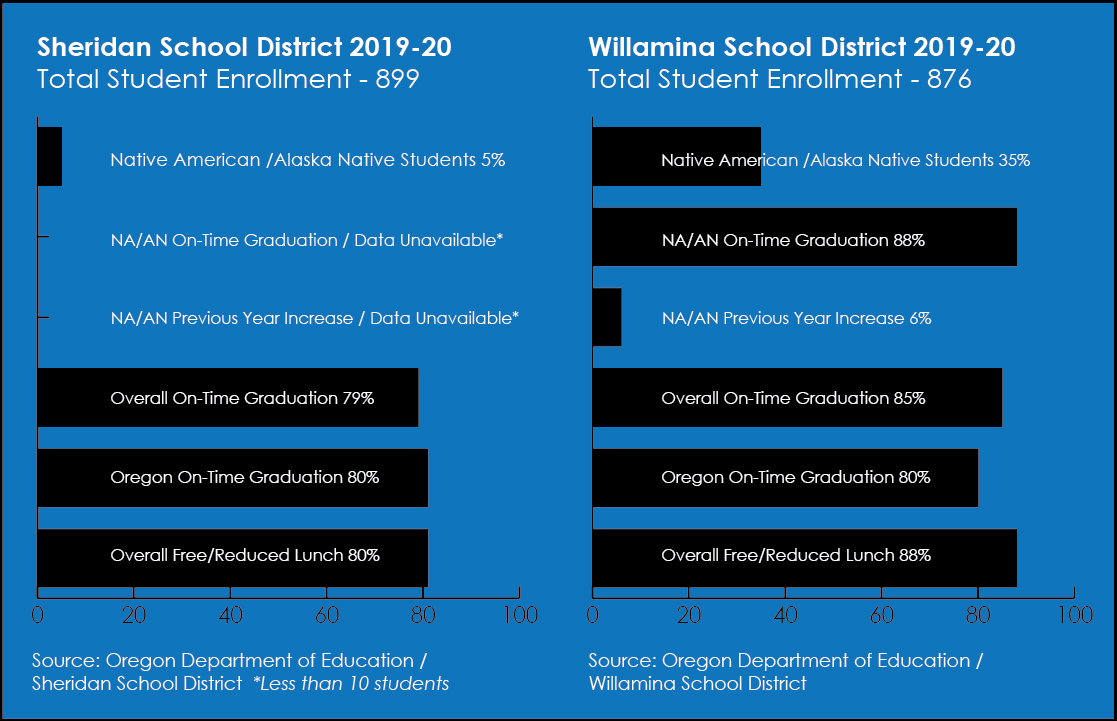Health & Education
On-time graduation rates for Native American students in Willamina continue to improve

By Danielle Harrison
Smoke Signals staff writer
The number of Native American students graduating high school within four years continues to increase in the Willamina School District despite the COVID-19 pandemic that has left schools shuttered since March.
Willamina saw a 6 percent increase, from 82 percent in 2019 to 88 percent in 2020. Approximately 35 percent of the Willamina student population identifies as Native American/Alaska Native.
In Sheridan, the statistics were unavailable due to the small number of students. If the number is 10 or fewer, the state doesn’t report the numbers.
Overall, the Sheridan district has 5 percent Native American/Alaska Native students.
The graduation information was part of Oregon’s annual school report card, which provides a snapshot of the state’s educational system and includes data about students, teachers and schools.
This year’s profiles do not include statewide assessment data, class sizes or attendance as a result of the school closures that started in March.
Overall, the four-year graduation rate for all students in Oregon is 80 percent.
“This annual data release comes roughly seven months after our students, families and educators started overcoming the toughest education challenge our state has ever faced,” Oregon Department of Education Director Colt Gill said. “I want to take a moment to reflect on the impressive grit and determination of our students, families and educators, and encourage them to keep persisting. We are with you, we support you and I know we’re all doing our best to return to in-person instruction as soon as possible.”
Willamina School District Superintendent Carrie Zimbrick said she is proud of the progress that Tribal students continue to make.
“During the (spring) closure we focused on our seniors to ensure they were not harmed by the pandemic,” she said. “The closure represented less than 2 percent of their time in K-12 education; those on track deserved to graduate and we made sure to give them the support to acquire those final credits. The Tribe has always been a supportive partner and we want to make sure they receive the high praise they deserve. By CTGR prioritizing education, the AI/AN students in Willamina have historically out-performed the same sub-group at the state level.”
Zimbrick said her goal for the district in the coming years is to achieve a 90 percent on-time graduation rate for all students.
“We have work to do, but we are making incredible gains,” she said. “Less than five years ago, we had rates in the mid-60s. Believe me, we are celebrating the 85 percent rate we earned this year and plan to keep improving that rate.”
With the pandemic keeping students in distance learning, Zimbrick said the focus this year is care and connection, which means personally reaching out to students and families who are not participating in school and to see how the district can assist them.
“The Tribe is an incredible partner and we have many Tribal education staff that push in to our programs in the typical school year,” Zimbrick said. “This year they are providing support virtually and onsite (at the Tribal campus), and communicating regularly with our staff. We have middle and high school students taking Chinuk Wawa classes, guided study classes, and at the elementary level we have students that participate in the half-day Chinuk immersion program.”
During the pandemic, the Tribe’s Youth Education program has offered Tribal students at $500 technology stipend, a local campus Internet classroom, academic advising and academic coaching, among other services.
Sheridan Superintendent Dorie Vickery began her job with the school district last summer, so she wasn’t present during the past academic year.
“We are trying to increase graduation rates for all student population groups falling below the state average,” Vickery said. “I think there are always improvements to be made when it comes to preparing students not just for the Oregon diploma, but post-high school options, higher education and/or trades. We are (also) working with Grand Ronde's Education Department for additional support, mainly academic tutors who work with our Native American students.”
